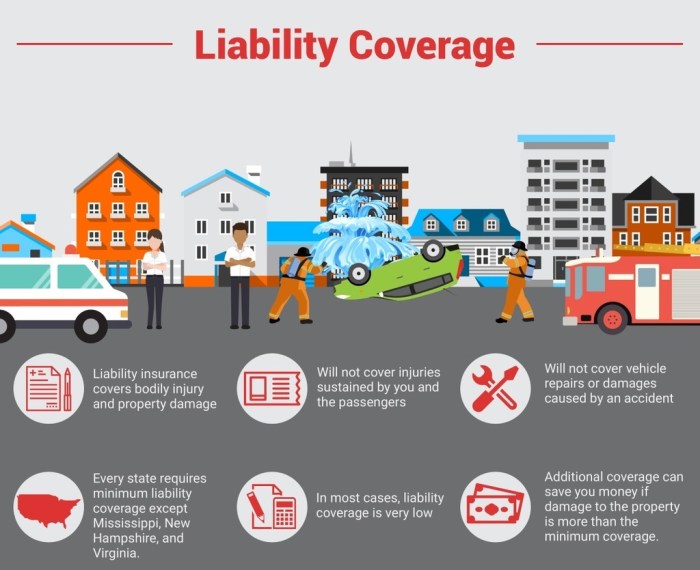Buckle up as we dive into the world of full coverage insurance. From understanding what it entails to exploring its benefits and cost-saving strategies, this guide will equip you with the knowledge to make informed decisions about your insurance coverage.
When it comes to protecting yourself on the road, full coverage insurance is the comprehensive solution that ensures you’re prepared for any unexpected twists and turns that come your way.
What is Full Coverage Insurance?
Full coverage insurance is a type of auto insurance policy that provides a higher level of protection compared to basic liability coverage. It typically includes a combination of coverage types to ensure comprehensive protection in various situations.
Types of Coverage Included in Full Coverage Insurance
- Collision Coverage: This helps cover the cost of repairing or replacing your vehicle if it’s damaged in a collision, regardless of fault.
- Comprehensive Coverage: This protects your vehicle from non-collision related incidents such as theft, vandalism, or natural disasters.
- Liability Coverage: This covers damages and injuries you cause to others in an accident where you are at fault.
- Uninsured/Underinsured Motorist Coverage: This helps cover your expenses if you’re involved in an accident with a driver who has insufficient or no insurance.
Examples of Situations Where Full Coverage Insurance is Beneficial
- Financing a Vehicle: If you have a car loan or lease, full coverage insurance is often required by the lender to protect their investment.
- Living in a High-Risk Area: If you reside in an area prone to theft, vandalism, or severe weather, comprehensive coverage included in full coverage insurance can be crucial.
- Driving a New or Expensive Vehicle: Full coverage insurance can help protect your investment in a new or high-value vehicle by covering repair or replacement costs in case of damage.
Key Differences Between Full Coverage and Liability Insurance
When it comes to insurance coverage for your vehicle, understanding the key differences between full coverage and liability insurance is crucial in making an informed decision. Let’s dive into the distinctions between these two types of coverage to help you choose the right option for your needs.
1. Coverage Extent
Full coverage insurance typically includes both liability coverage and comprehensive/collision coverage, providing a broader range of protection for your vehicle. On the other hand, liability insurance only covers damages or injuries you cause to others in an accident, without offering protection for your own vehicle.
2. Cost
Full coverage insurance tends to be more expensive than liability insurance due to the wider scope of coverage it offers. While liability insurance may be more affordable, it comes with limitations in terms of coverage for your own vehicle.
3. Limitations of Liability Insurance
Liability insurance may not be sufficient in scenarios where your vehicle is damaged in an accident that you are at fault for, leaving you to cover the repair costs out of pocket. Additionally, liability insurance does not provide coverage for theft, vandalism, or natural disasters, which are included in full coverage policies.
4. Scenarios Where Each Type of Insurance is Appropriate
- Full coverage insurance is ideal for new or expensive vehicles that you want to protect against a wide range of risks.
- Liability insurance may be suitable for older vehicles with a lower value, where the cost of full coverage may outweigh the benefits.
Understanding these key differences can help you make an informed decision when choosing between full coverage and liability insurance for your vehicle.
Factors Affecting Full Coverage Insurance Premiums
When it comes to full coverage insurance, several factors come into play when determining the cost of premiums. Understanding these factors can help you make informed decisions and potentially lower your insurance costs.
Age
Age is a significant factor that affects full coverage insurance premiums. Younger drivers, especially those under 25, are often considered high-risk drivers by insurance companies, leading to higher premiums. On the other hand, older, more experienced drivers typically pay lower premiums due to their driving history.
Driving Record
Your driving record plays a crucial role in determining your full coverage insurance premiums. A clean driving record with no accidents or traffic violations can help lower your premiums. On the contrary, a history of accidents, speeding tickets, or DUIs can result in higher insurance costs.
Location
Where you live can also impact your full coverage insurance premiums. Urban areas with higher traffic congestion and crime rates tend to have higher insurance costs compared to rural areas. Additionally, areas prone to natural disasters or extreme weather conditions may also lead to increased premiums.
Vehicle Type
The type of vehicle you drive can influence your full coverage insurance premiums. Luxury cars, sports cars, and vehicles with high repair or replacement costs typically have higher insurance premiums. On the other hand, safe, reliable, and economical cars usually come with lower insurance costs.
Strategies to Lower Premiums
To potentially lower your full coverage insurance premiums, consider the following strategies:
- Maintain a clean driving record by driving safely and avoiding traffic violations.
- Bundle your home and auto insurance policies with the same provider for possible discounts.
- Opt for a higher deductible to lower your premiums, but make sure you can afford the out-of-pocket expenses.
- Take advantage of any available discounts such as safe driver discounts, good student discounts, or discounts for safety features in your vehicle.
Benefits of Full Coverage Insurance

Full coverage insurance offers a wide range of benefits to policyholders, providing comprehensive protection in various circumstances.
Protection Against Unforeseen Events
- Full coverage insurance protects the policyholder in the event of accidents, theft, vandalism, or natural disasters.
- It covers damages to the insured vehicle, as well as medical expenses for injuries sustained in accidents.
- Having full coverage can offer peace of mind knowing that you are financially protected in unexpected situations.
Financial Security
- Full coverage insurance helps mitigate the financial burden of costly repairs or replacements in case of accidents.
- It can also cover legal expenses if you are sued for damages resulting from an accident.
- With full coverage, you can drive with confidence knowing that you have financial security in case of unforeseen events.
Flexibility and Additional Coverage
- Full coverage insurance often includes additional benefits such as roadside assistance, rental car reimbursement, and coverage for uninsured motorists.
- Policyholders have the flexibility to customize their coverage based on their needs and preferences.
- These additional coverages can provide extra protection and convenience for drivers.
Outcome Summary

As we wrap up our discussion on full coverage insurance, remember that investing in this type of insurance goes beyond just meeting legal requirements—it provides you with peace of mind and financial security in times of need. Stay informed, stay protected.